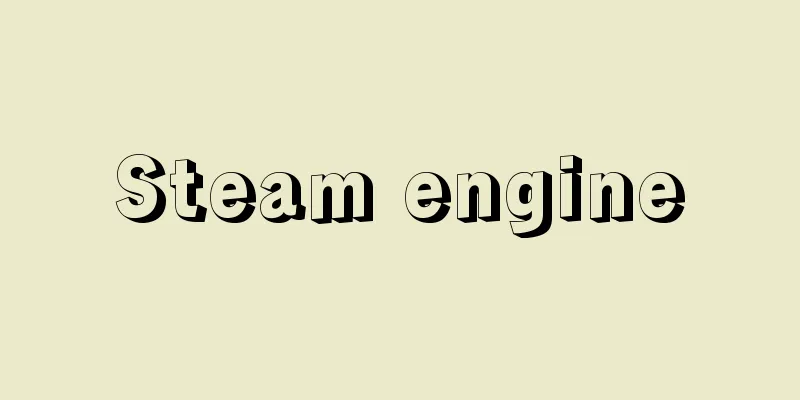Steam engine

|
A prime mover that converts the thermal energy of steam into mechanical work. Generally, it is a reciprocating engine that uses the pressure of steam generated in a boiler to move a piston in a cylinder, and obtains power from that motion. [Masatake Yoshida] historyFrom the end of the 17th century, the demand for metals increased with the growth of the population and the development of industry, and the development of mines became more active. As mining of ores progressed to deeper depths, spring water became a major obstacle. In traditional mines close to the surface, drainage was achieved by the power of horses and other animals, but in order to constantly drain the large amounts of spring water in deep mines, powerful power sources became necessary. In 1699, the Englishman Thomas Savery put the steam pumping engine, which uses steam energy directly to drain water, into practical use in response to the demands of mines. The principle is that steam is sent into a cylinder, and the water inside is expelled through a check valve into the upper pipe. Next, water is used from the outside to cool the steam and turn it back into water. When the steam turns into water, its volume is reduced to about one-hundred-thousandth, and the inside of the cylinder becomes close to a vacuum. Then, the water is pushed by atmospheric pressure into the cylinder from the lower pipe through the check valve. This water is then pushed out again by the steam force. In this way, the water is continuously drained by appropriately operating the valve that sends steam from the boiler. Around 1718, this pump was improved to spray a small amount of water in a mist into the cylinder to quickly turn the steam into water, and it was used for a long time. Since this pump relies on atmospheric pressure to draw water into the cylinder, it cannot be used if the water level is more than 10 meters above the water level to be drained, so in deep mines it was necessary to place the pump underground. In addition, the technology at that time had the disadvantage that water leaked from the pipe joints when pushing water up to a high place. There were examples of this pump being used to pump water and power a water wheel, but since mechanical work was not obtained directly from steam, it could not be called a true steam engine. Because it was difficult to operate the Savery steam pump underground, there was a demand for a pump that could be operated above ground. In 1712, Thomas Newcomen of England created the atmospheric engine, which was the first to use steam to drive a piston, which then drove a drainage pump consisting of a cylinder and a piston. It is also called a beam engine because there is a seesaw-like beam on both ends, with the pump rod and piston connected by chains. The cylinder and piston are poorly made, so air and steam leak, so a small amount of water is poured on top of the piston to stop the leakage. First, the valve from the boiler below is opened, steam is pumped into the cylinder to fill it up, and the valve is closed. Next, a vacuum is created by cooling it with water from outside the cylinder. The piston goes down due to atmospheric pressure, and the pump rod is pulled up. At this time, water enters the pump. When the piston hits the bottom, the drain valve is opened and the water in the cylinder is drained. The heavy pump rod goes down while pushing water out of the pump, and the piston goes up. This process is repeated by operating the valve. This engine was soon improved to spray cooling water into the cylinder, and the valve operation was changed from manual to linked to the movement of the piston, and it was used for a long time afterwards. Newcomen's engine was inefficient and required a large amount of coal, so it was not widely used outside of the UK. When James Watt of England was asked to repair it while working at the University of Glasgow, he noticed the drawbacks of the Newcomen engine and in 1765 created a device called a condenser, which directs steam into a container separate from the cylinder to cool it and turn it into water. This engine with a condenser was about four times more efficient than the Newcomen engine and was widely used as a practical engine. Watt continued to make improvements after that. If air enters the cylinder, a vacuum cannot be achieved even if the steam is cooled to turn it into water, so he attached an air pump to the condenser to remove the leaked air. He also placed a lid on the piston, made grooves around the area where the piston meets the cylinder and inserted a packing such as hemp, and inserted a packing in the area where the piston rod of the lid passes through, and sent steam between the piston and the lid to stop air from entering. Next, since the efficiency of the cylinder decreases when it cools, steam was sent around the cylinder to warm it. With this method, the piston can be pushed down by steam pressure above atmospheric pressure. Furthermore, around 1782, the steam sent to the top of the piston was stopped halfway through the piston's movement (cut off), and the expansion of the steam was used from that point onwards. The condenser was also improved so that it was only connected to the bottom of the piston, and the steam sent to the top of the piston was sent back to the bottom of the piston, pushing the piston up. Since the steam works twice in this way, it is called a double-acting system. With this method, the beam and the piston needed to be firmly connected in order to generate force when the piston went up, so in 1784 a link mechanism was created that firmly connected the circular motion of the tip of the beam with the linear motion of the piston. With this, the Watt-type beam engine was almost complete. As steam engines developed, they began to be used not only for draining mines, but also as a power source for general industrial use. In 1782, Watt attached a flywheel connected to a connecting rod and planetary gears to the pump rod of the beam, enabling it to drive rotating machinery. He also improved on the centrifugal governor that had been used in spinning machines and other machines, and devised a mechanism called Watt's governor, which moved a throttle valve to adjust the amount of steam and maintained a constant rotation speed. The planetary gear mechanism was later replaced with a crank and connecting rod, but this engine was widely used as a power source for factories and power plants. In 1802, William Murdoch of England, who became Watt's successor at the company, created a small double-acting engine in which part of the Watt-type valve was replaced with a simple slide valve operated by an eccentric wheel attached to the flywheel, and a combination of a steam intake and exhaust port. This type became the basic form of steam engines thereafter, and was used until the end of steam engines, with some improvements being made to it. As steam engines became widespread in factories and other places, there was a demand for small steam engines as a power source for transportation. However, the conventional Watt engines used pressures at about atmospheric pressure, so they were too large to be used in vehicles. For this reason, the development of high-pressure engines that used high-pressure steam at more than twice the atmospheric pressure and took advantage of the difference in atmospheric pressure, risking the risk of damaging the boiler, was promoted. In 1769, Nicolas-Joseph Cugnot of France created a steam car to pull a gun carriage using a high-pressure engine. In 1815, Oliver Evans in the United States created an engine that used steam at 14 atmospheres, and in 1802, Richard Trevithick in England created a small steam engine with a boiler and cylinder that used steam at 10.5 atmospheres. Trevithick's steam engine was small, efficient, and high-output, thanks to the development of a small fire-tube type boiler, the invention of a method of preheating the water sent to the boiler, and the invention of a method of promoting forced draft and smoke exhaust using used steam. Furthermore, in 1803, Trevithick created the first engine with horizontally placed cylinders, as opposed to the conventional type in which the cylinders were placed vertically with connecting rods protruding from above. This horizontal placement method became the mainstream for steam engines, from small transportation machines to large factory engines. In high-pressure engines, the steam used once is still at above atmospheric pressure, so a method was devised to continue using it in a Watt-type low-pressure engine, and in 1804 Arthur Woolf (1766-1837) of England created a compound engine in which high-pressure steam was used to move the piston of one cylinder, and the exhaust was used to move the piston of the next cylinder at low pressure. Later, knowledge was gained about the optimal piston area ratio for compound engines, and Watt-type beam engines were improved to compound types. Murdoch's slide valve was also improved, and in 1801 the Englishman Matthew Murray (1765-1826) used the expansion of steam and sized the valve so that the remaining steam would act as a cushion when the piston reached the end of the cylinder, allowing the valve to move more than 90 degrees faster than the piston due to an eccentric wheel attached to the crank. As a result of these improvements and the development of high-pressure engines, from the middle to the end of the 19th century, high-speed engines of around 400 revolutions per minute and large engines with pistons with a diameter of 2 meters and a length of 2.5 meters appeared. Also around this time, the British John Ramsbottom (1814-1897) created piston rings that fit into the piston grooves and bulge outward like springs, making it possible to withstand higher pressure steam. The mainstream steam engine is a horizontal high-pressure double-acting compound engine that uses a slide valve to regulate the flow of steam, and the final expansion is performed to a vacuum, as in the Watt type. As horizontal engines became larger and faster, a drop valve operated by a camshaft instead of an eccentric wheel was developed in 1841, and a swiveling shaft type Corliss valve was developed in 1849, instead of a slide valve, which takes time to open and close. These valves open and close quickly, and can effectively use the steam pressure almost from one end of the piston to the other. In addition, in conventional engines, the cylinder and valves are alternately heated and cooled because steam is let in and out of the cylinder at the same place, wasting the thermal energy of the steam. To eliminate this loss, a uniflow type engine, in which steam is let in from the end of the cylinder and exhausted from the center, was invented in 1885, and was put to practical use in 1908 using a drop valve as the inlet valve. Also, a new type of vertical engine, in which the piston and cylinder are at the top and the crank is at the bottom, unlike the early engines, was created around 1850 and used in pumping stations and power plants with small sites. After Trevithick built his first steam locomotive, steam engines began to be used for vehicles. It became necessary to easily change the engine speed and power output and to be able to rotate in reverse. In 1840, Robert Stephenson of England created a linkage with two eccentrics on the crankshaft for forward and reverse rotation, allowing the engine to rotate in either direction from a stop. In 1841, it was improved to allow adjustment of not only the direction but also the amount of steam sent to the piston, and it was used in steam locomotives, factories, power plants, ships, etc. Since Stephenson's linkage took up space, David Joy (1825-1903) of England came up with a linkage that performed the same function using only a link mechanism instead of an eccentric in 1879. This linkage did not take up much space, so it was often used in steam locomotives with cylinders placed between the wheels. In 1844, a similar linkage that did not use two eccentrics was also invented by Egide Walschaerts (1820-1901) of Belgium, and was used in the Locomotion. This link proved effective in the case of a cut-off where the steam supply was stopped midway through the piston's movement using high pressure steam. The use of superheated steam, which is steam heated to a temperature significantly higher than the boiling point of water, also began around 1925, but the use of steam engines gradually shifted to steam locomotives alone, and they were almost never used at all by the middle of the 20th century. This was due to the development of lighter and smaller steam turbines and internal combustion engines; nowadays turbines are used when large output is required, and internal combustion engines are used when small output is required. As steam engines can run on any fuel, research was carried out in Japan in the 1980s on using them as alternative fuel engines for automobiles, but it did not come to practical use. [Masatake Yoshida] formatThere are many types of steam engines. [1] Based on the method of supplying steam to the cylinder, they are classified as: (1) single-acting engines, in which steam is sent to only one side of the piston, and (2) double-acting engines, in which steam is sent alternately to both sides of the piston. [2] Depending on the state of the steam discharged from the engine, they are classified as follows: (1) non-condensing engines, which discharge steam directly into the atmosphere like steam locomotives; (2) condensing engines, which cool the exhaust gas, convert it to water like the Watt type, and reduce the pressure to near vacuum; and (3) back-pressure engines, which discharge steam without reducing it to atmospheric pressure and use it as heating steam in factories, etc. [3] In terms of the way steam expands, there are (1) a simple engine, which expands the steam completely in one cylinder, and (2) a compound engine or multi-expansion engine, which expands the steam successively in several cylinders. In a simple engine, the cylinder is cooled by low-temperature exhaust gas, which then cools the high-temperature steam that enters the cylinder, turning some of it into water, reducing efficiency. This can be avoided by using a uniflow engine. A compound engine has less temperature difference between the intake and exhaust gases, so it does not have this defect. [4] In terms of revolutions per minute, engines are classified as follows: (1) high-speed engines with revolutions per minute or more, (2) medium-speed engines with revolutions per minute between 100 and 200, and (3) low-speed engines with revolutions per minute or less. [5] Depending on how the engine is placed, there are (1) horizontal engines, in which the cylinders are horizontal, and (2) vertical engines, in which the cylinders are placed vertically. [Masatake Yoshida] FeaturesCompared to other heat engines, steam engines have a simple structure, are easy to handle, are highly reliable, and have an extremely long lifespan. In addition, because they use high-pressure steam produced in boilers, they have a strong rotational force when they start moving, and are also strong even at low speeds. They are also easy to reverse. However, they have the disadvantages of poor thermal efficiency and a low rotational speed, and they require a boiler and a condenser, and because they have large reciprocating pistons, it is difficult to make them small and lightweight, or to obtain high output. [Masatake Yoshida] structureThe main body is made up of a cylinder, a piston, a connecting rod, a crank, and a flywheel. The piston and the connecting rod are not directly connected, but rather a piston rod is attached to the piston to move it in parallel and at the same time to prevent the leakage of steam and air, and this is connected to a crosshead outside the cylinder through a packing, and the crosshead is then connected to the connecting rod. Steam passes through a throttle valve that adjusts the amount of steam, then through a steam distribution valve that determines the direction of steam flow, into the cylinder and moves the piston. A steam distribution valve is a valve that controls the flow of steam and opens and closes the supply and exhaust holes. There are three types: slide valves, drop valves, and Corliss valves. (1) A slide valve is a valve that moves along a flat surface inside a cylinder in the same way as a piston, and its flat surface opens and closes the supply and exhaust ports on the cylinder surface. Those that are in contact with the flat surface have a D-shaped cross section and are called D-shaped valves, while piston-shaped ones are called piston valves. D-shaped valves are airtight using the pressure of the steam supplied, so frictional resistance increases with high-pressure steam. Piston valves do not have this drawback and are used when the steam pressure is high. D-shaped valves supply air from the outside and exhaust to the inside of the valve, but piston valves usually supply air from the inside of the valve and exhaust to the outside. Slide valves are driven by an eccentric wheel attached to the crankshaft, and when supplying air from the outside like a D-shaped valve, they need to move more than 90 degrees faster than the piston, and when supplying air from the inside like a piston valve, they need to move less than 90 degrees behind the piston. (2) Whereas a slide valve opens and closes both the intake and exhaust ports with a single valve located in the center of the cylinder, a drop valve has separate valves for intake and exhaust, and is located at the end of the cylinder. The valves, which are closed by a spring, are opened by a cam driven from a side shaft placed parallel to the cylinder, so the opening and closing time is short. (3) The Corliss valve is used in the same way as the drop valve. This valve is a shaft-shaped valve operated by a cam and also opens and closes quickly. Steam engines for general factories and power plants only require a fixed direction of rotation, but for vehicles and small factories, it is necessary to be able to reverse the direction of rotation. The direction of rotation of a steam engine is determined by the relationship between the eccentric and the crankshaft. The reverser adjusts this relationship. There are linkages and radial devices. A linkage is a crankshaft with two eccentrics attached, and a typical example is the Stephenson valve mechanism. By continuously switching the connection between the two eccentrics and the slide valve, it is possible to rotate the engine in either direction from a stopped state, and the output can also be adjusted continuously. A typical example of a radial mechanism is the Walselt valve mechanism, which has one eccentric and uses the movement of a crosshead instead of another eccentric. This can also be adjusted to rotate in either direction from a stopped state, and the output can also be adjusted at the same time. While it is not necessary to maintain a constant rotation speed for long periods in vehicles and the like, it is necessary for power generation and the main driving force in factories, and a governor is required. There are two methods of speed regulation: adjusting the air intake throttle valve, and adjusting the movement of the steam distribution valve. Adjusting the throttle valve has the disadvantage that the throttle creates resistance, so shut-off speed regulation, which adjusts the movement of the distribution valve, is widely used. This can involve using double distribution valves, a movable eccentric wheel, or a Walselt valve mechanism. A governor is a device that keeps the rotation speed constant by changing the shut-off position and adjusting the output when the rotation speed changes due to fluctuations in the load. There are two types of governors: sleeve governors and shaft governors. Sleeve governors transmit the displacement of a centrifugal weight to a sleeve, which changes the intake throttle valve or the shutoff position. Shaft governors are attached to the crankshaft and use a centrifugal weight to move an eccentric wheel. [Masatake Yoshida] "Japan Automobile Research Institute, Research Report 54, Research on Rankine Cycle Engine Vehicles, Compilation of the Steam Automobile Research Committee Reports" (1988), edited and published by the Japan Automobile Research Institute " ▽ "Stephenson and the Steam Locomotive, by Colin Cresswell Dorman (1992, Tamagawa University Press)" ▽ "The History of Steam Power, by H.W. Dickinson, translated by Isoda Hiroshi (1994, Heibonsha)" ▽ "The Evolution of Engines: From Steam Engines to Environmental Engines, by Arai Hisaji (1998, Sankaido)" ▽ "Illustrated Guide to Steam Locomotive Mechanisms, by Hosokawa Takeshi (1998, Grand Prix Publishing)" ▽ "The Progress of Thermal Engineering: In Relation to the Evolution of Steam Power, by Nishikawa Kaneyasu (1999, Ohmsha)" ▽ "The Story of the Birth of the Steam Locomotive, by Mizushima Tohoru (2004, Grand Prix Publishing)" ▽ "Illustrated Complete History of Steam Locomotives" 2 volumes (2005, Gakken)" ▽ "Akira Saito's 200-Year History of Steam Locomotives (2007, NTT Publishing)" ▽ "John Robert Day Engines; The Search for Power (1980, The Hamlyn Publishing Group Ltd.)" [References] | | | | | | | | | | | |Trevithick |Condenser| | | | | |©Shogakukan "> The working principle of a steam engine (double acting) ©Shogakukan "> Reversing mechanism for steam engines Source: Shogakukan Encyclopedia Nipponica About Encyclopedia Nipponica Information | Legend |
|
蒸気の熱エネルギーを機械的な仕事に変換する原動機関。一般にはボイラーで発生させた蒸気の圧力でシリンダーの中のピストンを動かし、その運動で動力を得る往復動機関をいう。 [吉田正武] 歴史17世紀の末から、人口の増加と工業の発達につれて金属の需要が増え、鉱山の開発が盛んになった。鉱石の採掘がより深い所へと進むと、湧水(わきみず)が大きな障害になってくる。従来の地表に近い鉱山では、排水は馬など動物の力によっていたが、深い鉱山での多量の湧水を定常的に排水するために強力な動力が求められるようになった。 排水に直接蒸気のエネルギーを利用する蒸気ポンプ機関は、鉱山の要求にこたえて1699年イギリスのトーマス・セーベリーによって実用化された。原理は、ボンベ内に蒸気を送り、中の水を逆止め弁を通して上のパイプに追い出す。次に外側から水で蒸気を冷やして水に戻す。蒸気が水になると体積は10万分の1程度に減りボンベの中が真空に近くなる。そこで大気の圧力で押された水が下のパイプから逆止め弁を通ってボンベ内に入る。これをふたたび蒸気の力で押し出す。このようにボイラーから蒸気を送る弁を適当に操作することによって連続的に排水が行われる。このポンプは1718年ごろに、ボンベ内に少量の水を霧状に噴射して早く蒸気を水にするように改良され、長く使われた。このポンプはボンベへの水の取り入れを大気圧によっているので、排水する水の水面から10メートル以上高くなると使用できないから、深い鉱山では地中にポンプを置く必要があった。また高い所に水を押し上げると、当時の技術ではパイプの継ぎ目から水が漏れるなどの欠点があった。このポンプで水を汲(く)み上げ、それで水車を動かして使用した例もあるが、機械的な仕事を直接蒸気から得るのではないので、真の蒸気機関とはいえなかった。 セーベリーの蒸気ポンプを地中で運転するのはたいへんなので、地上で動かすポンプが要求されるようになり、1712年イギリスのトーマス・ニューコメンが、初めて蒸気を使用してピストンを動かし、それによってシリンダーとピストンからなる排水ポンプを動かす大気圧機関をつくった。両端に、ポンプ押し棒とピストンを鎖でつないだシーソーのようなビームがあるので、ビーム機関ともいわれる。シリンダーとピストンの加工が悪く空気や蒸気が漏れるので、ピストンの上にすこし水を入れて漏れを止めている。初めは下のボイラーから弁を開け、シリンダー内に蒸気を送って一杯にし弁を閉める。次にシリンダーの外から水で冷やして真空をつくる。大気圧でピストンが下がり、ポンプ押し棒を引き上げる。このときポンプに水が入る。ピストンが下についたとき排水用の弁を開け、シリンダー内の水を捨てる。重いポンプ押し棒は、水をポンプから押し出しながら下がり、ピストンは上がる。これを弁の操作で繰り返すのである。この機関はすぐに、シリンダー内に冷却水を噴霧するように改良され、また弁の操作は手動からピストンの動きに連動するようになり、その後長く使用された。 ニューコメンの機関は効率が悪く多量の石炭を必要としたので、イギリス以外ではあまり使われなかった。イギリスのジェームズ・ワットは、グラスゴー大学に勤務中に修理を依頼されたことから、ニューコメン機関の欠点に気づき、1765年に、蒸気をシリンダーとは別の容器に導いて冷やして水にする復水器という装置をつくった。この復水器をつけた機関はニューコメン機関の4倍程度の効率で、実用的な機関として広く使用された。その後ワットは改良を続けた。空気がシリンダー内に入ると、蒸気を冷やして水にしても真空が得られないので、復水器に空気ポンプをつけ、漏入した空気を抜いた。またピストンの上にシリンダーの蓋(ふた)をつけ、ピストンの周囲のシリンダーと接するところに溝をつけて麻などのパッキンを入れ、蓋のピストン棒が通るところにもパッキンを入れ、ピストンと蓋の間に蒸気を送り、空気が入るのを止めた。次に、シリンダーが冷えると効率が悪くなるので、蒸気をシリンダーの周りに送って温めた。この方法によって、ピストンは大気圧以上の蒸気の圧力で押し下げられるようになった。さらに1782年ごろ、ピストンの上に蒸気を送るのをピストンの動きの途中で止め(締め切りcut off)、それ以後は蒸気の膨張を利用することにした。また、復水器はピストンの下だけに連絡させ、ピストンの上に送った蒸気をまたピストンの下に送り、ピストンを押し上げるように改良した。これで蒸気は二度働くので複動式といわれる。この方法では、ピストンが上に行くときも力を出すため、ビームとピストンをしっかりつなぐ必要があり、1784年にビーム先端の円運動とピストンの直線運動をしっかりつなぐリンク機構をつくった。これでワット型のビーム機関はほぼ完成形になった。 蒸気機関が発達するにつれて、単に鉱山の排水用だけでなく、一般の工業用の動力源としての利用が始まった。ワットは1782年に、ビームのポンプ押し棒のついているほうに、コンロッド(連接棒)と遊星歯車でつながれたはずみ車を設け、回転する機械を動かせるようにした。さらに、前から紡績機などで使用されていた遠心式の調速機を改良して取り付け、それで蒸気量を調節する絞り弁を動かし一定回転数に維持できるワットの調速機とよばれる機構を考案した。その後、遊星歯車機構はクランクとコンロッドにかえられたが、この機関は工場や発電所の動力源として広く使用された。ワットの会社での後継者となったイギリスのウィリアム・マードックは、1802年にワット型の弁の一部をはずみ車につけた偏心輪で動かされる簡単な滑り弁と蒸気給排気孔の組合せにかえた小型の複動機関をつくった。この形式は以後蒸気機関の基本形となり、改良が加えられながら蒸気機関の最後まで使われた。 蒸気機関が工場などに普及すると、交通用の小型動力源としての蒸気機関が待望されるようになったが、従来のワットの機関は大気圧程度の圧力を利用するので形が大きく、車両用として使うのは無理であった。このため、ボイラーが破壊する危険を冒して大気圧の2倍以上の高圧蒸気を用い、大気圧との差を利用する高圧機関の開発が進められた。フランスのニコラス・ジョゼフ・キュニョーは1769年に、高圧機関を使って砲車を引く蒸気自動車をつくった。アメリカではオリバー・エバンズが1815年に、14気圧の蒸気を使用する機関をつくり、イギリスではリチャード・トレビシックが1802年に、10.5気圧の蒸気を使用する小型のボイラーとシリンダーが一体の蒸気機関をつくった。トレビシックの蒸気機関は、ボイラーに送る水の予熱と煙管形の小型ボイラーの開発、強制送風と使用済みの蒸気による排煙の促進を行う方法の発明とにより、小型で効率がよく、高出力を得られた。さらにトレビシックは1803年には、垂直にシリンダーを置き、上にコンロッドが出ている従来の形式に対して、初めてシリンダーを水平に置いた機関をつくった。この水平置きの方法は、小型の交通機械用から大型の工場用まで蒸気機関の主流となった。高圧機関では、一度使用した蒸気はまだ大気圧以上なので、これをワット型の低圧機関で続けて使用する方法が考えられ、1804年イギリスのアーサー・ウルフArther Woolf(1766―1837)は、初め高圧蒸気で一つのシリンダーのピストンを動かし、その排気で次のシリンダーでは低圧でピストンを動かす複式機関をつくった。その後、複式機関の最適なピストンの面積比についての知識が得られ、ワット型のビーム機関も複式に改良されたものが現れた。またマードックの滑り弁も改良され、1801年にイギリスのマシュー・マレーMatthew Murray(1765―1826)は、蒸気の膨張を使い、さらにピストンがシリンダーの端に行ったときに残った蒸気がクッションとなるように弁の寸法を決め、弁がクランクについた偏心輪によってピストンより90度以上早く動くようにした。 以上のような改良と高圧機関の発達により、19世紀中ごろから終わりにかけて、毎分400回転程度の高速機関や、ピストンの直径2メートル、長さ2.5メートルの大型機関も現れた。またこのころにはイギリスのジョン・ラムスボトムJohn Ramsbottom(1814―1897)によって、ピストンの溝に入っており、ばねのように外に張り出すピストンリングがつくられ、より高圧の蒸気にも耐えられるようになった。 蒸気機関の主流は、滑り弁で蒸気の流れを調節する横型の高圧複動複式機関で、最後の膨張はワット型と同じように真空まで行われる。横型機関が大型、高速化するに伴い、開閉に時間がかかる滑り弁ではなく、偏心輪にかわってカム軸で動かされるドロップ弁が1841年に、首振り軸型のコーリス弁が1849年に開発された。これらの弁は開閉が速く、ピストンの動きのほぼ端から端まで蒸気の圧力を有効に利用できる。また従来の形式の機関では、同じ場所でシリンダーに蒸気を入れたり出したりするために、シリンダーや弁が交互に加熱・冷却され、蒸気の熱エネルギーがむだになる。この損失をなくすために、蒸気をシリンダーの端から入れ、シリンダー中央から排気するユニフロー形式の機関が1885年に発明され、1908年に給気弁にドロップ弁を使って実用化された。また初期の機関とは異なり、ピストンとシリンダーが上、クランクが下にある新しい形式の縦型(たてがた)が1850年ごろつくられ、ポンプ場や敷地の狭い発電所などで使用された。 トレビシックが初めて蒸気機関車をつくってから車両用としても蒸気機関が用いられるようになった。そこで容易に機関回転数と出力を変更し、逆回転できることが必要となり、1840年にイギリスのロバート・スティーブンソンは、クランク軸に正逆回転用の二つの偏心輪をもち、停止からどちらへも機関を回転させられるリンクをつくった。1841年には、方向だけでなくピストンに送る蒸気量も調節できるように改良され、蒸気機関車、工場、発電所、船などで使用された。スティーブンソンのリンクは場所をとるので、イギリスのデビッド・ジョイDavid Joy(1825―1903)は1879年に、偏心輪のかわりにリンク機構だけによって同じ働きをするリンクを考えた。このリンクは場所をとらないので、シリンダーを車輪の間に置く蒸気機関車に多く使用された。また1844年には、同じように二つの偏心輪を使用しないリンク機構がベルギーのワルセルトEgide Walschaerts(1820―1901)によっても考え出され、ロコモーション号に使用された。このリンクは、高圧蒸気の使用により蒸気の供給をピストンの動きの途中で止めるカットオフの場合に有効性を発揮した。 また、蒸気を水が沸騰する温度よりかなり高い温度に加熱した過熱蒸気の使用も1925年ころから始まったが、蒸気機関の用途はしだいに蒸気機関車だけになり、20世紀の中ごろにはほとんど使用されなくなった。これは、より軽量・小型の蒸気タービンや内燃機関の発達によるもので、現在は大きな出力を要求される場合にはタービン、小出力では内燃機関が主流となっている。蒸気機関はどんな燃料でも使用できることから、代替燃料を用いるエンジンとして、日本でも1980年代に自動車用エンジンとして用いるための研究が行われたが、実用化には至らなかった。 [吉田正武] 形式蒸気機関には多くの形式がある。 〔1〕シリンダーへの蒸気の供給方式では、(1)ピストンの片側だけに蒸気を送る単動機関、(2)ピストンの両側に交互に蒸気を送る複動機関、に分けられる。 〔2〕機関から排出される蒸気の状態によって、(1)蒸気機関車のように蒸気をそのまま大気中に放出する不凝(ふぎょう)機関、(2)排気をワット型のように冷やして水にし、真空近くまで圧力を下げる復水機関、(3)蒸気を大気圧まで下げずに排出し、工場などの加熱用蒸気として使用する背圧(はいあつ)機関、に分類される。 〔3〕蒸気の膨張の仕方の違いでは、(1)一つのシリンダーで最後まで膨張させる単式機関と、(2)いくつものシリンダーで次々に膨張させる複式機関または多段膨張機関がある。単式ではシリンダーが低温の排気で冷やされ、次にシリンダーに入った高温蒸気を冷やして一部を水にし効率を悪くする。これはユニフロー機関を使用することによって避けられる。複式は給排気の温度差が少なく、この欠陥はない。 〔4〕回転数では、(1)毎分200回転以上の高速機関、(2)100回転から200回転までの中速機関、(3)100回転以下の低速機関、に分類される。 〔5〕機関の置き方によって、(1)シリンダーが水平な横型、水平型と、(2)垂直に置いた縦型機関がある。 [吉田正武] 特徴蒸気機関は他の熱機関と比較して構造が簡単で取扱いが容易であり、信頼性が高く、きわめて寿命が長い。またボイラーなどでつくった高圧の蒸気を使用するので、動き出すときの回転力が強く、低速でも力が強い。また逆回転が容易である。しかし、熱効率が悪く、回転速度が小さい欠点があり、またボイラーや復水器が必要で、大きなピストンが往復するために小型・軽量にしたり、大出力を得ることが困難である。 [吉田正武] 構造本体は、シリンダーとピストン、およびコンロッドとクランク、はずみ車からできている。ピストンとコンロッドは直接連結せず、ピストンを平行に動かし、同時に蒸気と空気の漏れを防止するために、ピストンにピストン棒をつけ、それをパッキンを通してシリンダーの外にあるクロスヘッドと連結し、クロスヘッドとコンロッドを連結している。 蒸気は、蒸気量を調節する絞り弁を通り、蒸気の流れ方を決定する蒸気分配弁を経てシリンダーに入りピストンを動かす。 蒸気分配弁は蒸気の流れを制御し、給排気孔を開閉する弁で、滑り弁、ドロップ弁、コーリス弁の3形式がある。 (1)滑り弁は、ピストンと同じようにシリンダー内を平面に沿って動く弁で、平面がシリンダー面にある給排気口を開閉する。平面と接する形のものは断面形がD形でD形弁とよび、ピストン型のものをピストン弁とよんでいる。D形弁は供給する蒸気の圧力で気密を保っているので、高圧蒸気では摩擦抵抗が大きくなる。ピストン弁はその欠点がなく、蒸気の圧力が高いときに用いられる。D形弁では外側から給気し、弁の内側に排気するが、ピストン弁では弁の内側から給気し、外側に排気するのが普通である。滑り弁は、クランク軸に取り付けられた偏心輪で駆動され、D形弁のように外側から給気するときはピストンより90度以上早く動かし、ピストン弁のように内側から給気するときは90度以下の遅れで動かす必要がある。 (2)ドロップ弁は、滑り弁がシリンダー中央にある一つの弁で給排気孔両方の開閉を行うのに対し、給気、排気それぞれ専用の弁で開閉し、シリンダーの端部に置く。シリンダーと平行に置いた側軸から駆動されるカムによって、ばねで閉じられている弁を開くので、開閉の時間が短い。 (3)コーリス弁は、ドロップ弁と同様に用いられる。この弁はカムで動かされる軸状の弁で、やはり開閉が速い。 一般の工場用や発電所用の蒸気機関は回転方向が一定でよいが、車両用や小型の工場用などでは回転方向を逆にできるようにする必要がある。蒸気機関の回転方向は偏心輪とクランク軸との関係によって決まる。この関係を調節するのが逆転装置である。これにはリンク装置とラジアル装置とがある。リンク装置はクランク軸に二つの偏心輪をつけたもので、代表例はスティーブンソン式弁機構である。二つの偏心輪と滑り弁との連結を連続的に切り換えることにより停止状態から正逆どちらの回転も可能で、出力の調節も連続的にできる。ラジアル装置の代表例はワルセルト弁機構で、偏心輪は一つで、他の偏心輪のかわりにクロスヘッドの運動を利用している。これも停止状態から正逆両方向に回転方向を調節でき、同時に出力の調節もできる。 車両用などでは長い間一定回転数を維持する必要はないが、発電用や工場の主原動力などではその必要があり、調速装置が要求される。調速には、給気の絞り弁を調節する方法と、蒸気分配弁の動きを調節する方法とがある。絞り弁を調節する方法は、絞りが抵抗となる不利があり、分配弁の動きを調節する締め切り調速が多く用いられている。これは、分配弁を二重にしたり、可動偏心輪を用いたり、ワルセルト弁機構を使用する。調速機は、負荷の変動によって回転数が変化すると、締め切り位置を変え出力を調整して回転数を一定にする装置である。 調速機にはスリーブ調速機と軸調速機がある。スリーブ調速機は遠心おもりの変位をスリーブに伝え、スリーブで給気絞り弁か、締め切り位置を変える。軸調速機はクランク軸に取り付け、遠心おもりで偏心輪を動かすようになっている。 [吉田正武] 『日本自動車研究所編・刊『日本自動車研究所研究報告54 ランキンサイクルエンジン自動車に関する研究 蒸気自動車研究委員会報報告総集編』(1988)』▽『コーリン・クレスウェル・ドーマン著『スティーブンソンと蒸気機関車』(1992・玉川大学出版部)』▽『H・W・ディキンソン著、磯田浩訳『蒸気動力の歴史』(1994・平凡社)』▽『荒井久治著『エンジン進化の軌跡――蒸気エンジンから環境エンジンへ』(1998・山海堂)』▽『細川武志著『蒸気機関車メカニズム図鑑』(1998・グランプリ出版)』▽『西川兼康著『熱工学の歩み――蒸気動力の変遷に関連して』(1999・オーム社)』▽『水島とほる著『蒸気機関車誕生物語』(2004・グランプリ出版)』▽『『「図説」蒸気機関車全史』全2巻(2005・学習研究社)』▽『齋藤晃著『蒸気機関車200年史』(2007・NTT出版)』▽『John Robert DayEngines ; The Search for Power(1980, The Hamlyn Publishing Group Ltd.)』 [参照項目] | | | | | | | | | | | | | | | | | | | | |©Shogakukan"> 蒸気機関の作動原理(複動式) ©Shogakukan"> 蒸気機関の逆転装置 出典 小学館 日本大百科全書(ニッポニカ)日本大百科全書(ニッポニカ)について 情報 | 凡例 |
<<: Steam locomotive - steam locomotive
Recommend
Planning Board Incident
In January 1941 (Showa 16), Planning Board invest...
On the Idea of Comedy
...The genres proposed by Diderot were "seri...
Halas, F. (English spelling) HalasF
…A Central European republic that existed from 19...
Tangram
...A game in which a square, rectangle, polygon, ...
Rebekah (English spelling) ribhqah Hebrew
The wife of Isaac, the patriarch of ancient Israel...
Golan Heights - Golan Heights (English spelling)
It is a strategic point that Israel captured from ...
Koremune Clan
During the Heian period, this clan made its living...
Hagoromo - Hagoromo
A plant of the Nymphaeaceae family native to North...
Passenger car marshalling yard
…A type of railway station that does not handle p...
Mandelbrot, BB (English spelling) MandelbrotBB
...Another simple self-similar figure in a set on...
cross-country
… [Nordic events] There are three types of events...
kulaputra
...A famous layperson in the Mahayana sutras is V...
Water ice
...They were especially popular in the post-World...
Shape memory effect
This effect was discovered by American TA Reed in ...
Zeng Pu (English spelling)
[Birth] Douji 11 (1872) [Died] 1935 China's fi...









